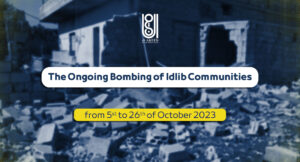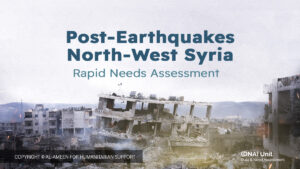The humanitarian situation in Northeastern Syria
hope this year will bring peace and health to you all and your respected families,
Al-Ameen Organization, in an attempt to capture a view of the humanitarian situation in North East of Syria in the communities, were in Ras Al Ein and Tell Abaid Pocket (RAATA area), performed Multi-Sectoral Needs Assessment, due to rapid change in the security situation and the demographic change on the ground.
In the eleventh year of the Syrian crisis, all country’s population faces huge humanitarian obstacles with continued conflict affecting civilians, lack of shelter, food and non-food items (NFIs), basic services, education services, drinking water, and other essential necessities.
This report provides a community-level analysis of the humanitarian situation in the North East of Syria in the communities wherein Ras Al Ein and Tell Abaid Pocket (RAATA area). It analyzed changes in major humanitarian sectors of displacement, shelter, NFI, food security and livelihood, protection, WASH, education, Health and emergency for four sub-districts (Ein Issa, Tell Abiad, Suluk, Ras Al Ain) over a period of three months from August to early November 2021.
This report is covering four sub-districts in Al-Hasaka and Ar-Raqqa governorates (Ein Issa, Tell Abiad, Suluk, Ras Al Ain, and Tel Tamer) with all sectors except health and nutrition sectors as it had been mentioned, the selection of the time period and area covered was informed by conflict dynamics and the humanitarian situation on the ground which changed after MSNA 2021.
Sampling was to take all sub-districts and communities that in Ras Al Ein and Tell Abaid Pocket in Al-Hasaka and Ar-Raqqa governorates to take an extensive and comprehensive overview of the situation in these sub-districts.
Al-Ameen Organization access in North East of Syria in the communities were in Ras Al Ein and Tell Abaid Pocket was to four sub-districts and 334 communities, in the meanwhile Data Collection Coverage targeted all sub-districts and communities in these covered sub-districts.
Data collection was completed through Key Informants KI interviews with at least five KI in each community (2,004 KIs) (%70 Males, %30 Female). Types of KI included a range of representatives of civilian bodies, such as local council members, teachers, NGO workers, and directors.
Al-Ameen Organization teams conducted face-to-face KI interviews. The selection of KI was based on the criteria of knowledge regarding population, local context and situation, professional background, leadership responsibilities or personal experience, gender balance…. etc.
The data analysis plan was based on a sub-district level but in some special questions, it depends on community-level data analysis.
For More information about NES (Ras Al Ein and Tell Abaid area) Needs overview, kindly find attached the report.
ALAMEEN would like to point out that the assessment of the need for the health sector will produce a special report later to ensure greater visibility in the region
As always for more info or any other inquiry please feel free to contact us.
Thanks & Regards




